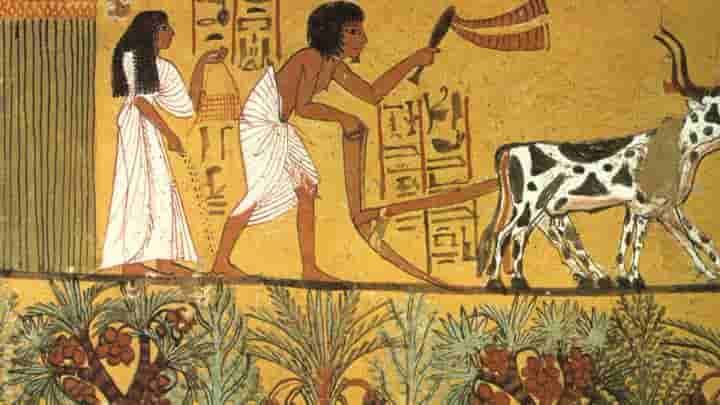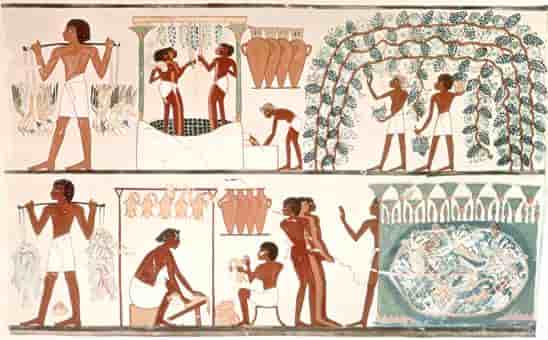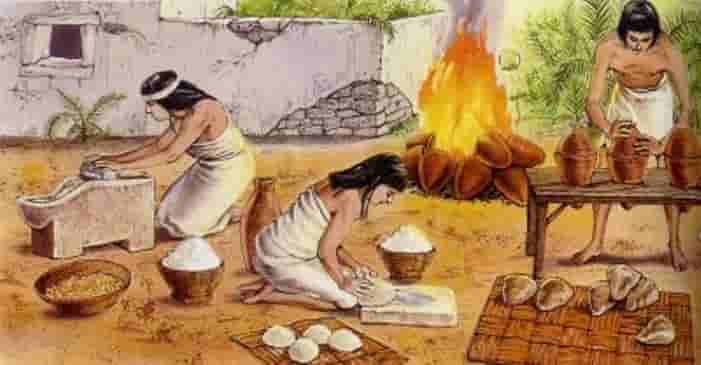Few articles inform us about the everyday life of the ancient Egyptians. What were their homes like? How did they educate their children? What did they eat? In this article, we will attempt to answer this last question, shedding light on the food habits of ancient Egypt and gaining insights into their daily lives.
The ancient Egyptians typically had two or three meals a day. At dawn, the poorer workers would have bread with onions, followed by a heartier meal later on.
The wealthier classes would have a light meal in the early hours and a substantial meal in the afternoon, which might last until the night. It is believed that the ancient Egyptians often used their hands to eat.
During meals, ancient Egyptians sat around a small table, while children would sit on cushions on the floor. The more privileged classes enjoyed a spread that included meat, fruit, bread, and beer. Royalty, in addition to these, indulged in wines and juices.
With the exception of the poor class, meat was accessible to most, though beef was reserved for royalty or specific groups such as butchers, as it was costly to feed large animals. A single animal could feed numerous people, and only royalty would sacrifice such animals for grand festivities, ensuring the surplus could be consumed over subsequent days.
Domestic birds, small livestock, and fish were available to all, as they were sourced through hunting. During that time, the Egyptian valley was much greener and wetter, fostering a diverse ecosystem of animal species coexisting together.
The middle class primarily raised sheep, pigs, and goats for their consumption or for sale in the markets.
Nevertheless, meat was not the most predominant food item. Ancient Egyptians relied heavily on vegetables, legumes, eggs, and milk as their main protein sources.
Vegetables, particularly onions, were accessible to all. Salads, lentils, and vegetables were the most common and widely consumed items among the ancient Egyptians, often accompanied by beer and bread.
Cereals were consumed by all social classes. Additionally, cakes filled with dates or figs were a delicacy enjoyed by the poorer classes on special occasions.
Was There Hunger in Ancient Egypt?
It was quite challenging to go hungry in Ancient Egypt. In such cases, hunger would typically result from the Nile failing to flood all the farmland or due to pest infestations destroying crops.
Normally, the ancient Egyptians were well-nourished as the society encouraged food sharing and communal meals. Additionally, the Nile River ensured that Egypt remained a vast granary, allowing them to store surplus crops in silos during years of bountiful harvests.
These storage facilities were managed by the royal administration to prevent potential famines.
Bread in Ancient Egypt
Information about the diet of ancient Egyptians can be gleaned from tombs, particularly from Offering Lists, which detail the required food items for the afterlife.
The staple of the ancient Egyptian diet primarily consisted of bread and beer. These grains were chosen because they were the most abundant crops in ancient Egyptian agriculture.
Regarding bread, there existed various types. The simplest was made with flour, water, and salt, while sweeter varieties included honey and dates, often baked in ceramic ovens.
Beverages in Ancient Egypt
Beer, a favorite beverage of the ancient Egyptians, was another essential part of their diet. The most basic method of preparation involved mixing partially baked bread crumbs with water and allowing it to ferment until it achieved the desired alcohol content.
Various types of beer existed, such as common beer, sweet beer, thick beer, and strong beer. However, it was common practice to dilute beer with water, as this was often given to laborers as part of their wages. If the beer was too strong, it could potentially affect a worker’s ability to carry out their duties properly.
Wine, on the other hand, was considered a luxury item reserved for special occasions. The finest wines in ancient Egypt came from regions like El Fayum or the Delta, but imported wines from other regions were also highly regarded.
The jars or amphorae used for storing wine were typically marked with the origin of the grapes as a distinguishing seal or signature. Additionally, sweet wines made from figs, dates, or pomegranates were produced.










